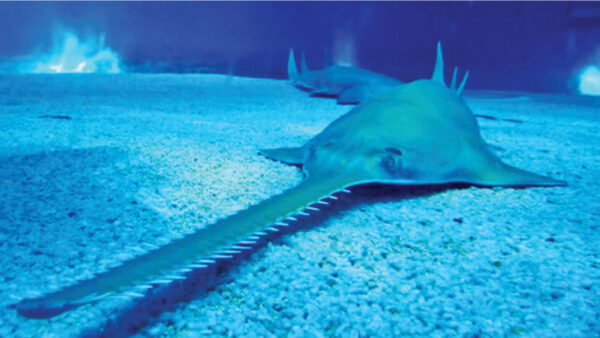With no recent sightings of sawfish,-by Polita Glynn and Nathan Fedrizzi

Source:Dailynews
In the waters off Sri Lanka, the number of sawfish, a rare and globally threatened group of marine rays, has declined so much that the animal is now considered “functionally extinct.” That finding, from a study by Pew marine fellow Rima Jabado in the August 2021 issue of the journal Aquatic Conservation: Marine and Freshwater Ecosystems, has spurred lawmakers to explore measures to protect the remaining sawfish in the country.
 Jabado and her colleagues at Blue Resources Trust, a nongovernmental organisation in Sri Lanka, interviewed more than 300 fishers and fish traders to investigate the distribution, species diversity, and health of Sri Lanka’s sawfish populations. Named for their saw-like snouts, sawfish are a type of ray whose skeleton is made primarily of cartilage. And like many shark and ray species, these animals are targeted for their fins, which can fetch high prices in the marine wildlife trade.
Jabado and her colleagues at Blue Resources Trust, a nongovernmental organisation in Sri Lanka, interviewed more than 300 fishers and fish traders to investigate the distribution, species diversity, and health of Sri Lanka’s sawfish populations. Named for their saw-like snouts, sawfish are a type of ray whose skeleton is made primarily of cartilage. And like many shark and ray species, these animals are targeted for their fins, which can fetch high prices in the marine wildlife trade.
“Our goal was to gather information on the status of sawfish in Sri Lanka by interviewing fishers across coastal communities, because they are most likely to have firsthand knowledge of these rare species,” said Jabado, who was awarded a Pew marine fellowship in 2019 for her research on the exploitation of guitarfishes and wedge fishes. “Observing declines in rare or elusive species can be challenging, in part because even when populations are healthy, they are encountered so infrequently in the wild.”
Once abundant in many parts of the world, all five of the living species of sawfish are now classified as either Endangered or Critically Endangered by the International Union for Conservation of Nature. These species, which are among the largest fishes in the sea, mature slowly and have few offspring, making them particularly susceptible to exploitation by humans. Once reduced, sawfish populations can take decades to rebuild.
Sawfish species have been recorded in Sri Lanka for more than a century, but no studies to assess their status in the country have been conducted until now. Research in other Indian Ocean countries found drastic population declines in recent decades, probably the result of targeted fishing, accidental entanglement in fishing gear—known as bycatch—and habitat loss from dredging, pollution, and coastal development.
Documenting decades of decline
To address this knowledge gap, Jabado and her colleagues conducted interviews at 21 sites around Sri Lanka’s coastline, asking fishers for information about the frequency and seasonality of sawfish sightings, the types of fishing gear used, and the value of sawfish meat or fins. Respondents were also asked about local names for individual sawfish species and their perceptions of the animals’ cultural significance.
“We found strong evidence for declining Sri Lankan sawfish populations, with knowledge of sawfishes increasing with the age of study participants,” Jabado said.
No respondents, ages 20–29, could identify sawfishes from illustrations or reported seeing them in the wild. Conversely, all respondents, ages 70-79, could identify and have seen the animals. The median year in which sawfishes were last observed by respondents was 1992, indicating that population declines extend back several decades.
 The team also found that language provided historical insights about the distribution of sawfish species. Although the researchers could confirm the presence of only one species from photographs and dried specimens, study respondents from Northern Sri Lanka provided local names for two different types of sawfish—a finding consistent with older checklists indicating two sawfish species in the area.
The team also found that language provided historical insights about the distribution of sawfish species. Although the researchers could confirm the presence of only one species from photographs and dried specimens, study respondents from Northern Sri Lanka provided local names for two different types of sawfish—a finding consistent with older checklists indicating two sawfish species in the area.
The study authors attribute sawfish declines in Sri Lanka to a combination of factors, chiefly fishing, which intensified suddenly in the 1950s in concert with rapidly expanding fisheries and peaked in the 1980s.
The researchers also cite expansion of the aquaculture industry, which can degrade or destroy mangrove forests and pollute lagoons and estuaries—all key habitat and nursery grounds for sawfish. Aquaculture production in Sri Lanka expanded in the 1970s and peaked in 1998, coinciding with the estimated period of sawfish declines.
Connecting policy with science
In a strong example of research, informing environmental management, Jabado and the team from Blue Resources Trust presented evidence from the study to policymakers in the Sri Lankan Fisheries Ministry and worked with them to implement listings for local wedge fish and giant guitarfish species under the Convention on International Trade in Endangered Species of Wild Fauna and Flora, including the development of Non-Detriment Findings (NDFs). NDFs are an assessment of whether international trade in a given species is likely to negatively affect its survival. In the case of wedge fish and giant guitarfish, a negative NDF would amount to a ban on the export of meat or fins from Sri Lanka.
“Collaborative studies such as this help highlight the realities of our shark and ray populations in Sri Lanka,” said Daniel Fernando, Founder of Blue Resources Trust. “And armed with this information, we can guide policymakers to implement management that will reduce pressures on threatened sharks and rays.”
In collaboration with Blue Resources Trust, Jabado organised several workshops in Sri Lanka to train more than 60 fisheries officials guiding them to identify guitarfish and wedge fish fins—the other two groups of species at the centre of her Pew fellowship project—and is working with decision-makers to recommend a ban on sawfish fishing in the country. Because so few sawfish are left, the regulations are unlikely to have a significant impact on fishers.
“I welcome the engagement of decision-makers on this issue to give the remaining sawfishes, wedge fishes, and guitarfishes a better chance at survival,” Jabado said. “The lessons we learn from protecting this species group will also be useful for guiding future science-based management of sharks and rays.”
(Polita Glynn is project director and Nathan Fedrizzi is a principal associate with the Pew Fellows Programme in Marine Conservation)






















